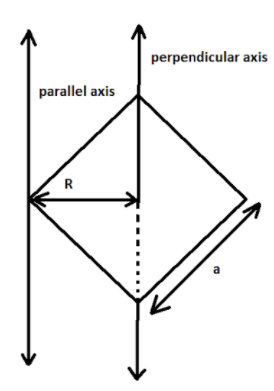
Consider a uniform square plate of side $a$ and mass $m$. The moment of inertia of this plate about an axis perpendicular to its plane and passing through one of its corner is:
A) $\dfrac{5}{6}m{a^2}$
B) $\dfrac{1}{{12}}m{a^2}$
C) $\dfrac{7}{{12}}m{a^2}$
D) $\dfrac{2}{3}m{a^2}$
Answer
218.1k+ views
Hint: To solve this question we have to apply a parallel axis theorem. According to this theorem, the moment of inertia along an axis parallel to the original axis will be the sum of the moment of inertia along the perpendicular axis and the product of mass and the distance between the perpendicular axis and parallel axis.
Formulae used:
${I_{parallel}} = {I_{perpendicular}} + M{R^2}$
Here ${I_{parallel}}$ is the moment of inertia along the parallel axis, ${I_{perpendicular}}$ is the moment of inertia along the axis through the centre of mass, $M$ is the mass of the object and $R$ is the distance between the centre of mass and the parallel axis.
Complete step by step answer:
In the question, a uniform square plate of side $a$ and mass $m$ is given. Let’s draw a figure.

From the above figure, we can easily find $R$ using the Pythagoras theorem,
$ \Rightarrow R = \sqrt {{a^2} - {{\left( {\dfrac{a}{2}} \right)}^2}} = \dfrac{a}{{\sqrt 2 }}$
We know that for a square plate, the moment of inertia along a perpendicular axis passing through the centre of mass is,
$ \Rightarrow {I_{perpendicular}} = \dfrac{{m{a^2}}}{6}$
So, using the parallel axis theorem, we get
$ \Rightarrow {I_{parallel}} = {I_{perpendicular}} + M{R^2}$
Here ${I_{parallel}}$ is the moment of inertia along the parallel axis, ${I_{perpendicular}}$ is the moment of inertia along the axis through the centre of mass, $M$ is the mass of the object and $R$ is the distance between the centre of mass and the parallel axis.
Substituting the value of $R$ and ${I_{perpendicular}}$ we get
$ \Rightarrow {I_{parallel}} = {I_{perpendicular}} + M{R^2}$
$ \therefore {I_{parallel}} = \dfrac{{m{a^2}}}{6} + \dfrac{{m{a^2}}}{{{{\left( {\sqrt 2 } \right)}^2}}} = \dfrac{2}{3}m{a^2}$
So the required answer is $\dfrac{2}{3}m{a^2}$. Hence option (D) is correct.
Note: While solving questions related to moment of inertia, make sure to apply the correct formulae. There are two different theorems i.e. parallel axis theorem and perpendicular axis theorem. Always use the correct theorem. The parallel axis theorem is used for axes parallel to the centroidal axis of the body. However, the perpendicular axis theorem is used for axes that are perpendicular to the centroidal axis of the body.
Formulae used:
${I_{parallel}} = {I_{perpendicular}} + M{R^2}$
Here ${I_{parallel}}$ is the moment of inertia along the parallel axis, ${I_{perpendicular}}$ is the moment of inertia along the axis through the centre of mass, $M$ is the mass of the object and $R$ is the distance between the centre of mass and the parallel axis.
Complete step by step answer:
In the question, a uniform square plate of side $a$ and mass $m$ is given. Let’s draw a figure.

From the above figure, we can easily find $R$ using the Pythagoras theorem,
$ \Rightarrow R = \sqrt {{a^2} - {{\left( {\dfrac{a}{2}} \right)}^2}} = \dfrac{a}{{\sqrt 2 }}$
We know that for a square plate, the moment of inertia along a perpendicular axis passing through the centre of mass is,
$ \Rightarrow {I_{perpendicular}} = \dfrac{{m{a^2}}}{6}$
So, using the parallel axis theorem, we get
$ \Rightarrow {I_{parallel}} = {I_{perpendicular}} + M{R^2}$
Here ${I_{parallel}}$ is the moment of inertia along the parallel axis, ${I_{perpendicular}}$ is the moment of inertia along the axis through the centre of mass, $M$ is the mass of the object and $R$ is the distance between the centre of mass and the parallel axis.
Substituting the value of $R$ and ${I_{perpendicular}}$ we get
$ \Rightarrow {I_{parallel}} = {I_{perpendicular}} + M{R^2}$
$ \therefore {I_{parallel}} = \dfrac{{m{a^2}}}{6} + \dfrac{{m{a^2}}}{{{{\left( {\sqrt 2 } \right)}^2}}} = \dfrac{2}{3}m{a^2}$
So the required answer is $\dfrac{2}{3}m{a^2}$. Hence option (D) is correct.
Note: While solving questions related to moment of inertia, make sure to apply the correct formulae. There are two different theorems i.e. parallel axis theorem and perpendicular axis theorem. Always use the correct theorem. The parallel axis theorem is used for axes parallel to the centroidal axis of the body. However, the perpendicular axis theorem is used for axes that are perpendicular to the centroidal axis of the body.
Recently Updated Pages
Chemical Properties of Hydrogen - Important Concepts for JEE Exam Preparation

JEE General Topics in Chemistry Important Concepts and Tips

JEE Atomic Structure and Chemical Bonding important Concepts and Tips

JEE Amino Acids and Peptides Important Concepts and Tips for Exam Preparation

JEE Extractive Metallurgy Important Concepts and Tips for Exam Preparation

Algebra Made Easy: Step-by-Step Guide for Students

Trending doubts
JEE Main 2026: Application Form Open, Exam Dates, Syllabus, Eligibility & Question Papers

Derivation of Equation of Trajectory Explained for Students

Hybridisation in Chemistry – Concept, Types & Applications

Understanding the Angle of Deviation in a Prism

Understanding Collisions: Types and Examples for Students

Understanding Atomic Structure for Beginners

Other Pages
JEE Advanced Marks vs Ranks 2025: Understanding Category-wise Qualifying Marks and Previous Year Cut-offs

Units And Measurements Class 11 Physics Chapter 1 CBSE Notes - 2025-26

NCERT Solutions For Class 11 Physics Chapter 8 Mechanical Properties Of Solids

Motion in a Straight Line Class 11 Physics Chapter 2 CBSE Notes - 2025-26

NCERT Solutions for Class 11 Physics Chapter 7 Gravitation 2025-26

How to Convert a Galvanometer into an Ammeter or Voltmeter




